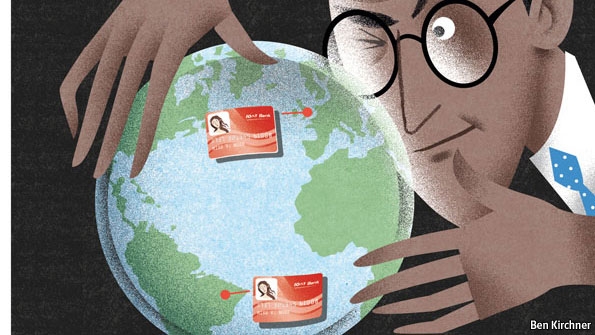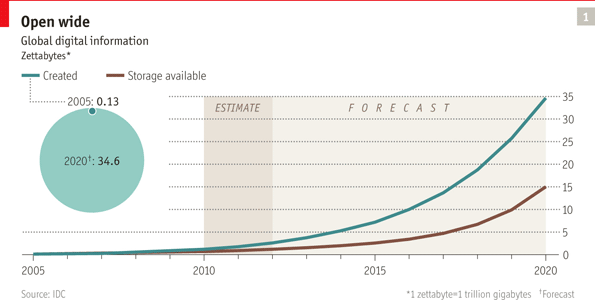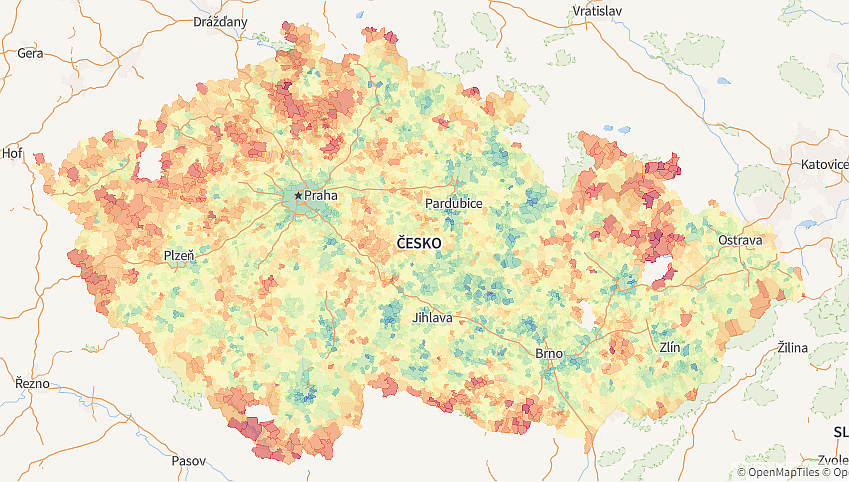
Banky toho o svých zákaznících vědí opravdu hodně. Tyto informace mohou být užitečné i jinak… Zdroj: The Economist (from the print edition)
Watson became something of a celebrity after beating the champion human contestants on “Jeopardy”, an American quiz show. Its skill is to be able to process millions of documents quickly by reading and “understanding” ordinary written language. Computers have no trouble with searching data neatly sorted in databases. Watson’s claim to fame is that it can do the same with “unstructured data” such as those found in e-mails, news reports, books and websites. IBM hopes that Watson may, in time, do some of the work that human analysts do now, such as reading the financial pages of newspapers, looking at thousands of company results and forecasts and producing a list of companies that might be takeover targets soon.
Citigroup has hired Watson to help it decide what new products and services (such as loans or credit cards) to offer its customers. The bank doesn’t say so, but Watson’s first job may well be to try to cut down on fraud and look for signs of customers becoming less creditworthy. If so, Watson will be following other computers designed to deal with “big data”. Across a slew of new firms in Silicon Valley and in big banks across the world, a range of new ideas is being tried to crunch data. Some have the potential to change banking from the bottom up.
In most financial institutions the immediate use of big data is in containing fraud and complying with rules on money-laundering and sanctions. Even seemingly simple tasks, such as checking the names of clients against those on a sanctions blacklist, become immensely complicated in the real world, where banks may have thousands of customers with the same names as those on the blacklist. Each becomes a false positive that may embarrass the bank and ruin a client relationship. So banks have had to turn to computers that can amass data from a variety of different sources, including the customer’s nationality and address, the names of family members, and whether they have travelled to or received money from countries on sanctions lists.
When moving on to more complex tasks, such as identifying the tiny percentage of fraudulent transactions among the millions of legitimate ones, the demands become ever greater. The problem is getting bigger because as banking has moved onto computers and mobile phones, and payments have shifted from cash to cards or electronic transfers, the opportunities for fraud have proliferated.
The danger of fraud is particularly acute in areas such as card payments and some of the more innovative kinds of money transfers that are offering cheaper or more convenient services than those already available. PayPal, which dominates online payments, barely survived its first year in business after it came under sustained attack from fraudsters, and several of its early rivals were cleaned out and had to close down.
PayPal came up with Igor, a computer system named after a Russian thief and hacker who had opened fake accounts and taunted the firm’s security team in e-mails. Igor would look for patterns, such as a concentration of payments close to the top limit and their destinations, and then compare those payments with all the others in the system. What started at PayPal soon spread to the rest of banking and beyond it.
A better kind of crystal ball
The firm that has perhaps gone furthest in finding useful connections in disparate databases is Palantir Technologies, which takes its name from the magical all-seeing crystal balls of J.R.R. Tolkien’s mythology. It was founded by a group of PayPal alumni and backed by Peter Thiel, one of PayPal’s co-founders. Its speciality is building systems that pull together information from different places and try to find connections. Some of its earliest adopters have been spy agencies. In America the CIA and the FBI use it to connect individually innocuous activities such as taking flying lessons and receiving money from abroad to spot potential terrorists. Its other main market is in banking, where big firms such as JPMorgan and Citi use it for a range of activities from structuring equity derivatives to reducing loan losses.
A stablemate of sorts to Palantir is Xoom, a firm that specialises in cross-border remittances. It is backed by some of Palantir’s investors and has swapped a senior employee with it, but more importantly it shares Palantir’s belief that given enough data even the toughest risks can be managed. Xoom accepts payments from bank accounts or debit cards in America, then hands over cash in countries such as the Philippines or India. It does not have much time to find out if it has been swindled on a payment before it has to produce the cash. So it has devised a sophisticated computer system that analyses a range of data, the nature of most of which it will not disclose.

Some of these checks may seem obvious, but some are not easy to do when processing millions of transactions and moving billions of dollars. Moreover, few of these pieces of information on their own are powerful enough signals for Xoom to decline or agree to make a payment. Yet when the computer looks at all of the payments in its system, it is remarkably good at weaving together the bits of information to spot fraud.
It also learns as it goes. When it recently noticed a string of payments funded by Discover credit cards and originating in New Jersey, its algorithms raised a red flag even though each payment looked legitimate. “It saw a pattern when there shouldn’t have been a pattern,” says John Kunze, Xoom’s chief executive. The pattern it found turned out to have been an effort by a criminal gang to defraud the firm.
The other big users of fraud-fighting computers are credit-card associations such as Visa and MasterCard. Their systems, as well as those of big card issuers such as Capital One, look at vast numbers of transactions for unusual patterns or connections. This has allowed them to graduate from simple rules-based fraud detection (such as whether a credit card has been swiped in locations a long way apart in a short space of time) to more complex sorts.
None of these systems is cheap, but they are usually a lot cheaper than falling victim to fraud. Xoom puts its losses through fraud at 0.35% of the sums transferred. The average for credit-card firms is about 0.1%, and the best achieve rates of about half of that, says Mike Gordon of FICO, the company that invented credit-scoring and now also supplies fraud-detection software. Losses on cashed cheques in America run to about 1% a year. For companies selling goods online, loss rates are considerably higher. CyberSource, an electronic-payment and risk-services company, says that online retailers in Britain reckoned on losses of 1.8% of revenue last year.
The high cost of fighting card fraud has changed the balance of competition in banking, weakening smaller banks that lack the scale to build the necessary systems. Many closed or sold their own credit-card businesses and instead signed their customers up to cards issued by large specialists such as MBNA or Capital One. Many smaller banks now think this was a mistake, depriving them not only of an important source of revenue but also of the opportunity to form the deeper and more lasting relationship with their customers that comes from selling them several financial products. Most important of all, perhaps, it has deprived them of a rich source of data on their customers‘ spending patterns.
That may soon change, for two reasons. The first is that card associations such as Visa and MasterCard are getting better at spotting fraudulent transactions as they pass through the network, relieving the burden on smaller banks, says FICO’s Mr Gordon. The main strength of these network-level systems is that they are able to look at far more transactions than any single bank could, which helps them to spot fraud patterns on an international scale.
Second, the systems used to crunch data are becoming commoditised and their price is coming down. Thomson Reuters reckons that last year venture firms invested a total of $2.47 billion in companies that want to crunch big data. Much of this investment was in database and storage outfits that are not specific to banks, yet the tools being developed elsewhere are quickly spreading. Whereas a decade ago the big banks would get their systems custom-made at huge cost, smaller banks can now buy similar ones off the shelf at a small fraction of the price.
Bankinter, the tech-savvy small Spanish bank, last year started using a system to analyse complex loan portfolios on computers run by Amazon, an online retailer. Cloud computing enables it to hire massive number-crunching capacity whenever it needs it. These two factors are making it easier for smaller banks the world over to keep their credit-card businesses to themselves and lean against the powerful forces for more and more consolidation in banking.
Panning for gold
As the ability to process large amounts of data becomes ubiquitous, banks are discovering that it is good for far more than fighting fraud. These data also contain hidden nuggets of gold.
One way of using them is to try to sell customers more products. Santander sends out weekly lists to its branches of customers who it thinks may be interested in particular offers from the bank, such as home insurance. Some of the products banks are offering are not even financial. In Singapore Citigroup keeps an eye on customers‘ card transactions for opportunities to offer them discounts in stores and restaurants. Citi has more than 250 people in Asia working on data analysis. Last year it opened a new “innovation lab” in Singapore that brings together those data analysts with big institutional customers and a large analytics centre in Bangalore.
If a customer who has signed up for this service swipes a credit card, the system can look at the time of day, the location and the customer’s previous shopping or eating habits. If it finds that he enjoys Italian food, it is almost lunchtime and there is a nearby trattoria, it can send a text message offering a discount at the restaurant. That may give the bank a second transaction and a cut of the extra spending. What makes the system even creepier is its ability to find out what proportion of customers take up such offers, so it can continuously learn to improve them. The model for this is Amazon’s online store, which recommends items that a customer might like based not only on what he has bought previously but also on what similar customers have bought.

McKinsey reckons that some banks have been able to double the share of customers that accept offers of loans and reduce loan losses by a quarter, simply by using data they already have. Card networks and other retailers are also getting in on this business. In America Visa has teamed up with Gap, a clothes retailer, to send discount offers to cardholders who swipe their cards near Gap’s stores. Yet in peering so obviously into people’s spending habits, banks run a risk of spooking their customers and running foul of privacy advocates. Target, an American retailer, received unwelcome attention earlier this year when it reportedly discovered from a teenage girl’s shopping patterns that she was pregnant —and mailed her baby-related coupons—before she had told her father.
A less controversial way of using the data banks hold is to draw on them to offer something genuinely useful to their customers. Britain’s Lloyds Banking Group is thinking of tweaking its systems to tell customers not just how much money is in their accounts when they ask for a balance, but also how much they will have available once all their usual bills are paid. “We have deep and rich information about customers that we can use to give them better insights, rather than just providing us with better insight to improve our risk management,” says Alison Brittain, head of consumer banking at Lloyds.
Yet even as big data are helping banks, they are also throwing up new competitors from outside the industry. One such firm is ZestCash, which provides loans to people with bad or no credit histories. It was started by Douglas Merrill, a former chief information officer and head of engineering at Google. The big difference between ZestCash and most banks is the sheer quantity of data that the firm crunches. Whereas most American banks rely on FICO credit scores, thought to be based on 15-20 variables, such as the proportion of credit that is used and whether payments have been missed, ZestCash looks at thousands of indicators. If a customer calls to say he will miss a payment, most banks would see this as a signal that he is a high risk. But ZestCash has found that such customers are in fact more likely to repay in full. Another useful signal is the length of time customers spend on ZestCash’s website before applying for a loan. “Every bit of data is noise, but when you add enough of them together in a clever enough way you can make sense of the garbage,” Mr Merrill said at a recent conference.
ZestCash’s customers are not typical bank customers because of their poor credit histories. Most would normally use payday lenders. Mr Merrill says his firm’s interest rates are about a third of those charged by many payday lenders (although still an eye-popping 300% or so), and that it is achieving defaults of well under half the payday industry’s average of 40%.
Wonga, a British start-up that offers loans for very short periods, also looks at a plethora of different data sources, such as e-mail-address and social-network sites, to make credit decisions on the fly. Another firm, Cignifi, digs deep into mobile-phone records, crunching variables such as the time when calls were made, their frequency and the whereabouts of the callers for clues about their propensity to repay loans. (Disclosure: Jonathan Hakim, the president and CEO of Cignifi, used to work for this newspaper.) “Banks have to keep up in this arms race,” says Thomas Achhorner of the Boston Consulting Group. “They have to make sure they know at least as much about their own customers as any third party could know.”
Tesco, a large British retailer, collects enormous amounts of data on its customers‘ shopping habits that allow it to send precisely targeted coupons. When a household starts buying nappies, signalling the arrival of a new baby, Tesco usually sends discount vouchers for beer, knowing that the new father will have less opportunity to go to the pub. The firm also has banking ambitions. It already offers credit cards and loans and plans to introduce full bank accounts. Given the depth of its databases, it may well assess the creditworthiness of its customers on the basis of their grocery shopping.
Other firms help customers at the expense of banks. Mint, an online financial planner, pulls together all of a customer’s financial information from different places. A customer may have his current accounts with one bank and perhaps a few credit cards with other banks. Mint allows him to see exactly how much he has (or owes) in total. Two San Francisco start-ups are trying to take this idea a step further. ReadyForZero and SaveUp also aggregate information and help customers cut their debts with a mixture of advice and gentle nudges. ReadyForZero, for instance, posts stickers to its customers so they can cover up the magnetic strips of their credit cards if the interest rates are especially high. SaveUp offers prizes and rewards to those who cut their debt. Yet others, such as Zopa or Prosper, bypass banks entirely, letting savers lend directly to borrowers.
A question of trust
The danger for banks is that websites such as these stand between them and their customers. If customers trust websites such as Mint more than they trust their banks, the banks could end up having to provide commoditised financial products at ever narrower margins. They may even lose their role as intermediaries between savers and borrowers. Andrew Haldane, who has a reputation as a blue-sky thinker at the Bank of England, reckons that with access to enough information about one another, investors and savers may no longer need banks.
“With open access to borrower information, held centrally and virtually, there is no reason why end-savers and end-investors cannot connect directly,” he said in a recent speech. “The banking middlemen may in time become the surplus links in the chain. Where music and publishing have led, finance could follow.” Mark Jenkinson of Capco, a consultancy, foresees the emergence of a financial market in which consumers own and control their financial records and give banks access to them only when they want to do business with them.
Such a world is not yet imminent. For now, most data aggregators operate in America because of the widespread adoption there of financial-planning tools such as Quicken into which users download their financial records. Yet the idea is spreading, presenting banks with a dilemma. Some, such as Citigroup, are trying to bring all their customers‘ data into the bank. Intuit, the company behind both Mint and Quicken, as well as a rival firm, Yodlee, sell software to banks that allows their customers to see their spending and balances across all of their accounts.
Others are concerned about the reputational and security risks that might arise from importing or sharing data. BNP Paribas, for instance, is providing its customers with powerful tools to analyse their spending, but will not import data on customers‘ accounts at other banks. “The customer wants power over his data,” says Virginie Fauvel, its online-banking director. But “there is too much risk in aggregation…the bank has to be a safe place.”
One obvious strategy is for banks to offer incentives to their customers to do more business with them, thus centralising both their transactions and the information. Standard Chartered, for instance, offers cheaper loans to customers who have multiple accounts with the bank, largely because it thinks the extra information allows it to assess risk more accurately. Another method is for banks to follow their customers out into the physical world by offering them new ways of paying or borrowing on the fly. The most obvious example is mobile banking and payments.







